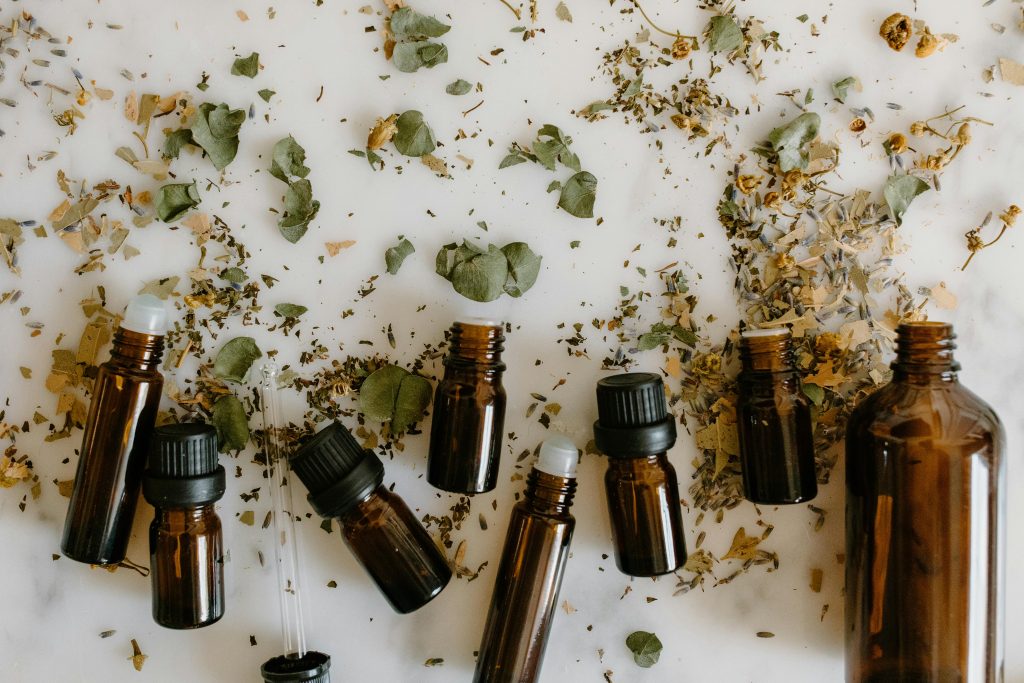Supporting Perimenopause Naturally

Perimenopause is a natural phase in a woman’s life that marks the transition to menopause. It is characterised by fluctuating hormone levels, which can cause a variety of physical and emotional symptoms, including hot flashes, mood swings, irregular periods, sleep disturbances, and vaginal dryness. While hormone replacement therapy (HRT) is a common treatment, many women seek natural alternatives to manage their symptoms due to concerns about the side effects or risks associated with HRT.
Herbal medicine has gained popularity as a complementary approach to managing perimenopause symptoms. Many plants contain compounds that can help balance hormones, reduce inflammation, and support overall health during this transition. We’ll explore some of the most well researched herbs for perimenopause and how they may help alleviate common symptoms.
Common Symptoms of Perimenopause
Before diving into the herbs, let’s first look at some of the most common symptoms that women may experience during perimenopause:
Hot flashes and night sweats: Sudden feelings of intense heat, often accompanied by sweating, which can occur during the day or at night.
Irregular menstrual cycles: Changes in the frequency, duration, or heaviness of menstrual periods.
Mood swings and irritability: Emotional fluctuations due to hormonal shifts.
Sleep disturbances: Difficulty falling asleep or staying asleep.
Vaginal dryness: Reduced lubrication in the vaginal area, leading to discomfort during intercourse.
Fatigue and brain fog: Feeling tired, forgetful, or having difficulty concentrating.
Herbal remedies can be used to alleviate these symptoms by addressing hormonal imbalances, supporting adrenal function, or promoting relaxation and sleep.
Herbal Remedies for Perimenopause Symptoms
Herbal medicine is highly individualised, as the treatment and effectiveness of herbs can vary based on a person’s unique health condition, symptoms, genetics, and lifestyle factors. It is important to consult with a medical herbalist to ensure you are taking the right herbs for you.
1. Black Cohosh (Actaea racemosa)
Black cohosh is one of the most widely studied herbs for managing perimenopausal symptoms, particularly hot flashes and night sweats. It has been used for centuries in Native American and European herbal medicine.
How it works: Black cohosh is thought to work by acting on serotonin receptors in the brain and mimicking oestrogen, although it doesn’t contain oestrogenic compounds. This action may help reduce the frequency and intensity of hot flashes (Langer et al., 2005).
Evidence: Several clinical studies have found that black cohosh significantly reduces hot flashes, vaginal dryness, and mood swings in perimenopausal women (Tesch et al., 2016).
Considerations: While black cohosh is generally considered safe for short term use, it should be avoided by those with liver conditions, and long term use should be discussed with a medical herbalist.
2. Red Clover (Trifolium pratense)
Red clover is rich in isoflavones, which are plant compounds that mimic oestrogen in the body. It has been widely studied for its potential to alleviate hot flashes and support overall hormonal balance during perimenopause.
How it works: Isoflavones in red clover are phytoestrogens, which may help alleviate symptoms related to oestrogen deficiency, such as hot flashes, night sweats, and vaginal dryness (Clark et al., 2001).
Evidence: Studies suggest that red clover extract can reduce the frequency and severity of hot flashes. One study published in Menopause found that women who took red clover experienced a significant reduction in hot flashes compared to a placebo group (Kaiser et al., 2009).
Considerations: Red clover is generally well tolerated, but its oestrogenic effects mean it should be used cautiously in women with a history of hormone sensitive conditions like breast cancer.

3. Dong Quai (Angelica sinensis)
Dong quai, often referred to as the “female ginseng,” is a traditional Chinese herb commonly used to support women’s health, particularly for hormonal balance. It has been used to treat menstrual irregularities, menopause symptoms, and even conditions like PMS.
How it works: Dong quai contains compounds that may help regulate hormone levels and support the endocrine system. It is thought to balance oestrogen levels, making it helpful for perimenopausal women experiencing hormonal fluctuations (Lee et al., 2013).
Evidence: Dong quai has been shown to help alleviate symptoms like hot flashes and menstrual irregularities, although more research is needed to confirm its efficacy (Choi et al., 2014).
Considerations: Dong quai should not be used by women with a history of hormone-sensitive cancers or blood clotting disorders, as it can have anticoagulant effects.
4. Chaste Tree Berry (Vitex agnus-castus)
Chaste tree berry, or Vitex, has been used in traditional medicine for centuries to treat menstrual irregularities and hormone imbalances. It is often used to support women through perimenopause, especially for mood swings, irritability, and irregular periods.
How it works: Vitex works by stimulating the pituitary gland, which helps regulate the production of hormones such as progesterone and oestrogen. It can also help stabilise menstrual cycles and reduce symptoms of PMS (Koppiker & Sequeira, 2012).
Evidence: Studies suggest that Vitex may be effective in reducing symptoms like mood swings, hot flashes, and breast tenderness in perimenopausal women (Zhao et al., 2013).
Considerations: Vitex is generally well tolerated, but it may interact with hormonal medications, including birth control or HRT. Women who are pregnant or breastfeeding should avoid using it.

Herbal medicine can be an effective way to manage the symptoms of perimenopause, offering a natural alternative to hormone replacement therapy. Herbs like black cohosh, red clover, dong quai, and chaste tree berry have been shown to help alleviate common symptoms such as hot flashes, mood swings, sleep disturbances, and menstrual irregularities.
However, it’s important to remember that herbal remedies are not a “one-size-fits-all” solution. It’s essential to consult with a healthcare provider before starting any herbal treatments, especially if you have pre-existing health conditions or are taking other medications. When used wisely and in combination with a healthy lifestyle, herbal medicine can help ease the transition through perimenopause and improve overall wellbeing.
References
Choi, Y. J., Ahn, S. Y., & Lee, Y. S. (2014). The effects of Angelica sinensis (Dong Quai) in the treatment of perimenopausal symptoms: A systematic review. Journal of Ethnopharmacology, 151(2), 902-909. https://doi.org/10.1016/j.jep.2013.11.013
Clark, J. L., Dunlop, S. A., & Stokes, E. J. (2001). Phytoestrogen effects of red clover on hot flashes in perimenopausal women: A double-blind, placebo-controlled trial. Maturitas, 39(3), 195-201. https://doi.org/10.1016/S0378-5122(01)00272-5
Kaiser, F., Kallweit, U., & Grundmann, J. (2009). Efficacy of red clover (Trifolium pratense) in the treatment of menopausal symptoms: A double-blind, placebo-controlled trial. Menopause, 16(3), 506-512. https://doi.org/10.1097/gme.0b013e3181a92b38
Koppiker, N., & Sequeira, E. (2012). Efficacy of Vitex agnus-castus in perimenopausal symptoms: A systematic review. Phytotherapy Research, 26(11), 1682-1686. https://doi.org/10.1002/ptr.4662
Langer, R. D., White, L., & Maric, M. (2005). Black cohosh for the treatment of hot flashes: A double-blind, placebo-controlled study. The Journal of Clinical Endocrinology & Metabolism, 90(10), 5675-5681. https://doi.org/10.1210/jc.2005-0530
Lee, H., Lee, M. S., Choi, T. Y., Lee, H. J., Lee, M. K., Shin, B. C., & Ernst, E. (2013). Dong quai (Angelica sinensis) for menopausal symptoms: A systematic review and meta-analysis of randomized controlled trials. Menopause, 20(2), 172-179. https://doi.org/10.1097/GME.0b013e31826de7f1
Tesch, B., Rost, U., & Wutte, N. (2016). Efficacy of black cohosh in relieving menopausal symptoms: A meta-analysis. Maturitas, 91, 1-8. https://doi.org/10.1016/j.maturitas.2016.06.002
